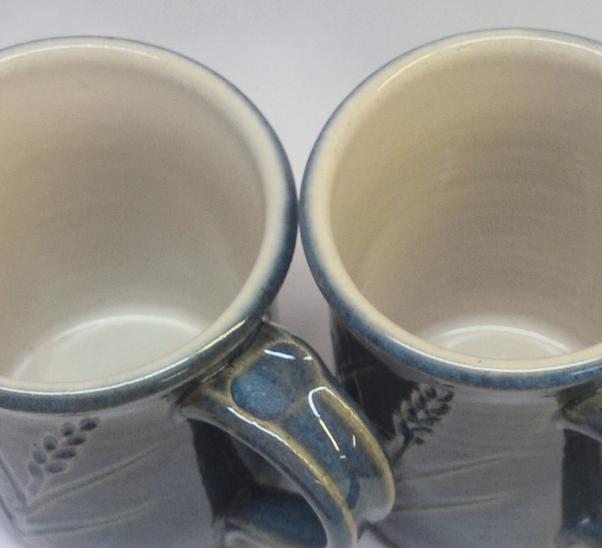| Monthly Tech-Tip | No tracking! No ads! |
A functional matte liner glaze is possible - with care.
Ravenscrag G2928C matte liner glaze is on the insides of these mugs. Like our G2934 recipe, this matte glaze needs to be fired to a real cone 6 and fired in the C6DHSC drop and hold and then slow-cooled schedule. If cooled too slowly the surface could be too matte would be subject to cutlery marking (especially on the inside bottoms). If cooled too quickly it will be too glossy. When firings cool slowly just because they are tightly packed the degree of matteness can be tuned by blending in just enough glossy glaze to make the surface smooth enough to be functional while still matte enough to be attractive to the eye and the touch.
Related Pictures
Meet two glazes at the rim using wax emulsion. Why? How?

This picture has its own page with more detail, click here to see it.
Reactive glazes (melt-mobile, crystallizing or heavily pigmented) are the least suitable for food surfaces because they have the potential to leach metals. Liner glazing ware is an excellent way to deal with this problem. Not only does this approach improve functionality but it can be aesthetically pleasing and practical in production.
This liner is GA6-B, a pottery glaze recipe we promote with confidence. Not only is it less likely to be leaching metals but also less likely to craze - this assures water tightness on non-vitreous bodies and eliminates any potential for bacteria growth in the cracks (especially if the body has porosity). Unfortunately, glazes that leach are also likely to stain and cutlery mark - these add more reasons why they are most often unsuitable for food surfaces.
The straightness of the dividing line is affected by both the application technique and the degree to which the two glazes bleed into each other and run. Read and watch our liner glazing step-by-step and liner glazing video for details on how to do this - it is practical for any potter or hobbyist (or even in production). And tap/click the picture above for other examples of this.
Videos
Links
| Recipes |
G2928C - Ravenscrag Silky Matte for Cone 6
Plainsman Cone 6 Ravenscrag Slip based glaze. It can be found among others at http://ravenscrag.com. |
| Glossary |
Food Safe
Be skeptical of claims of food safety from potters who cannot explain or demonstrate why. Investigate the basis of manufacturer claims and labelling and the actual use to which their products are put. |
Got a Question?
Buy me a coffee and we can talk

https://backup.digitalfire.com, All Rights Reserved
Privacy Policy

